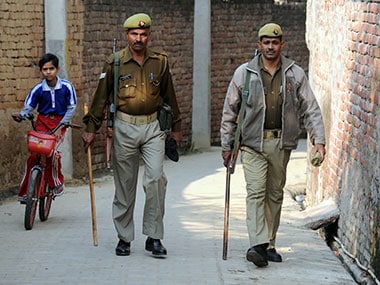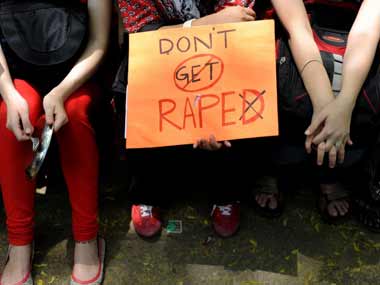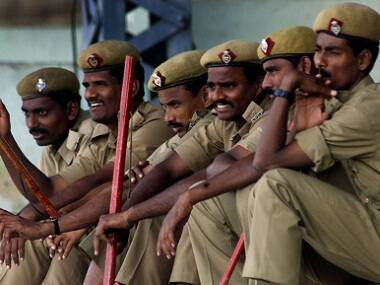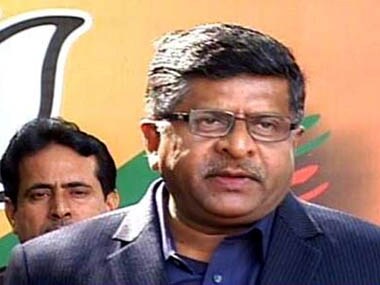The kidnapping, gang rape and murder of a sixteen-year old girl who was dragged from her bicycle while returning from school last week has once again brought the spotlight on the large number of rapes which eventually result in murder.
This incident occurred on National Highway 91 near Chandpur village, adjoining the city of Bulandshahr in Meerut district. The girl was tailed by an Alto car, and the attackers got down, dragged her into the car and then sped away. When the girl’s parents went to file an FIR, it was dismissed as a case of elopement. Later, when the girl’s dead body was found in a Greater Noida canal, the Senior Superintendent of Police G Muniraj claimed that the matter was a love affair gone awry and obviously the reason for the murder.

Representational image. AFP
Had the CCTV footage confirming that the girl had been forcibly abducted not surfaced, the police would have stuck to their theory of "elopement".
Uttar Pradesh has witnessed a 400 percent rise in cases of child rape in 2016 according to data collated by the National Crime Records Bureau (NCRB). However, the chief minister of the state Yogi Aditya Nath came up with an "epic" response to these brutal rapes and murders. He was quoted as saying: "They should be sent to the same place as gangsters have been sent or evil persons in the epics." The chief minister also went on to praise the police for the determination they have shown in their fight against organised crime.
Meanwhile, the deadly cocktail of rape and murder is being played out at a horrible frequency. Stats released by the NCRB show that while 20,000 children were raped in 2016, the figure stood at 10,934 in 2015. Many of these rapes have ended in the murder of the child victim.
The question to be asked is why the 'stricter laws' to curb sexual violence against women are not working?
This phenomenon of rape followed by murder came into the limelight with the notorious Badauni gang rape case. Two Dalit cousin sisters were gangraped, tortured and then hanged from a mango tree on 27 May 2014 in the village of Sadatganj in Uttar Pradesh. Within two weeks of the case, even before the public outrage and media coverage could die down, three more Dalit girls were gangraped with one of them left murdered in Badouni district.
Reacting to the surge in number of rape cases resulting in murder of the victim, Dr Rajesh Kumar, head of the Society of Promotion of Youth and Masses, which works with juvenile delinquents and murderers, said, "When the rape law was being amended in 2013, I had pointed out the pitfalls of tightening the law. If the victim survives, she will be a witness. The rapist therefore finds it more convenient to eliminate the witness."
The new rape laws issued in 2013 had mandated shorter trials and stricter punishment for the rapist.
Kumar went on to elucidate the mind set of the rapist saying, "Juvenile or adult rapists have no positive understanding of society. They are looked down upon as objects of hate and so they in turn end up hating everyone around them. For many of those who commit these crimes, there is little difference between living on the streets or spending time in a jail. Murdering the key witness will ultimately, they believe, help them in a court of law."
The Bulandshahr rape is reminiscent of another case from May last year in the city. Four women of a family were also gang raped in mid-May 2017 in Bulandshahr when they were carrying money to help a pregnant relative. Their car was being driven by a close relative, who was shot dead by the robbers when he tried to protest.
If the national crime figures are to be compared with state-specific statistics, it is evident that the increase in number of rape cases each year in Uttar Pradesh has been twice the national average. While India recorded an increase of 65 percent in rape cases from 2010 (22,172) to 2014 (36,735), Uttar Pradesh recorded an increase of 121 percent from 2010 (1,563) to 2014 (3,467) according to the NCRB data. Rapes by juvenile offenders increased from 1,688 in 2015 to 1,903 last year, almost a 13 percent jump.
Commenting on these figures, former inspector general of police and presently Governor of Puducherry, Kiran Bedi, said that an increase in rape and murder and in fact all crime can be reversed only by improving ground policing systems.
Bedi had informed this reporter earlier that the primacy of beat patrolling which is the backbone of policing is being systematically annihilated across our cities.
Between 1980-86, when she had headed the Delhi police force, policemen used to patrol the streets of the capital round-the-clock. Bedi said, "We also ensured that the public was equally involved in our efforts and made sure public personalities were involved in these patrolling efforts. The result of this public and police partnership was that there was a sharp decline in crime. These joint efforts must be brought back."
Meanwhile, Kumar believes strong steps need to be taken to improve institutional care. "In western countries, the state has created institutions where if parents are not taking care of a child, the state will step in. In India, traditionally, children have been nurtured by families and communities. Both have broken down. All forms of social control have disappeared. We have a society which is imploding in all directions."
The result is there for all to see. We have a large underclass of boys who have grown up receiving no educational or vocational skills. Many of them are on substance abuse and lead a life of crime to be able to afford these drugs.
The escalating graph of rape and murder cases is also linked to the low conviction rate of rapists. Statistics collected by the NCRB has shown that conviction rate for rape has been as low as 25 percent in the past.
Sloppy investigation by the police and factors like, political clout, money power and caste biases in key cases are also responsible for the present situation.
This was clearly brought out in the Badauni rape and murder case. The CBI team was brought in to give further teeth to the investigation but it allowed the five upper caste suspects to walk away scot-free.
The CBI, according to senior lawyer Rebecca John, twisted the rape-murder of the two cousins to make it appear to be a case of honour killing. They even raised a doubt on whether the girls had been sexually assaulted. And since the village was flooded due to a heavy rainfall, it became impossible to exhume the bodies of the girls. The five upper class alleged perpetrators could walk free because they had money and political clout.
But John refuses to see a co-relation between the stricter rape law, and the rise in cases of murder of the raped victim. John said, "We have become an increasingly lawless society and the increasing number of cases of rape and murder are a consequence of the breakdown of law and order. Women and children remain the most vulnerable section of society and therefore they are targeted the most."
John also believes the time has come for courts to give greater primacy to cases of rape, murder and other heinous crimes. "When I joined the law practise in 1988, there was only one special court dealing with corruption while the other courts dealt with cases of murder, rape and other heinous crimes. Today, 26 special courts are dealing on a daily basis with a few cases of corruption, while a handful of courts are having to deal with a large number of pending rape and murder cases. No wonder sentences in such cases take a long time to be delivered," she added.
NCRB data further shows a 873 percent increase in rape cases during the last five decades.
Talking about the psychology of rapists, Dr Ashish Nandy, a noted sociologist, concurred with the views of Kumar. Nandy pointed out, "Young boys are being driven from their homes onto the streets, where they invariably get sexually assaulted by truck drivers and others and grow up holding a grudge against society. Making laws more strict will not remove the problem. Earlier parenting was shared in an extended family. Now we are down to single parents and kids are being left to fend for themselves. But before we arrive at conclusions, a great deal of research needs to be done in this field."
Nandy also rues the fact that there are few studies in India on rape, the psychology of rapists and also on the impact of pornography on rapists, if any.
Can the increase in rape be linked to increasing media coverage to cases of rape? The chairperson for the Uttar Pradesh state commission for women believes that this rising graph can be attributed also to women coming out in larger number to report these cases.
NCRB data confirms that with 164 rapes being reported everyday, a woman is being raped every hour in India. An increasing number of these women end up being murdered. This is only the tip of the iceberg and there seems to be little that the government is doing to reverse this horrific trend.
Published Date: Jan 10, 2018 17:45 PM | Updated Date: Jan 10, 2018 17:45 PM

















